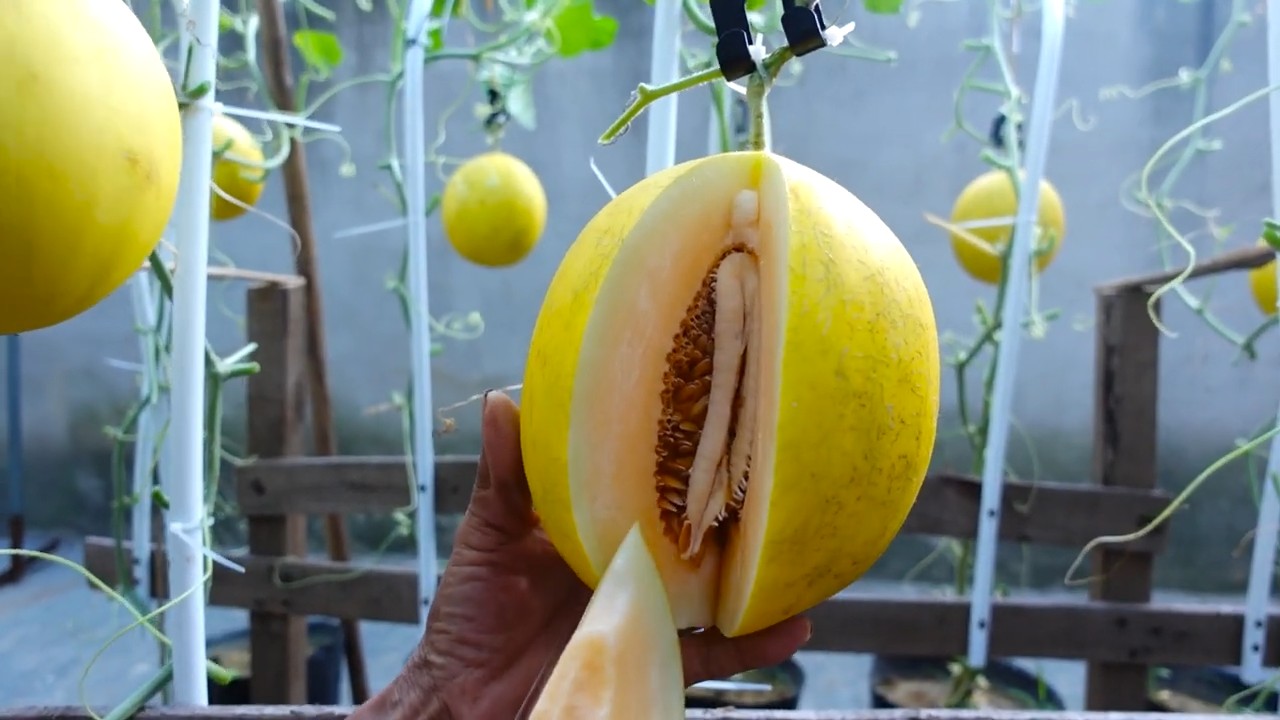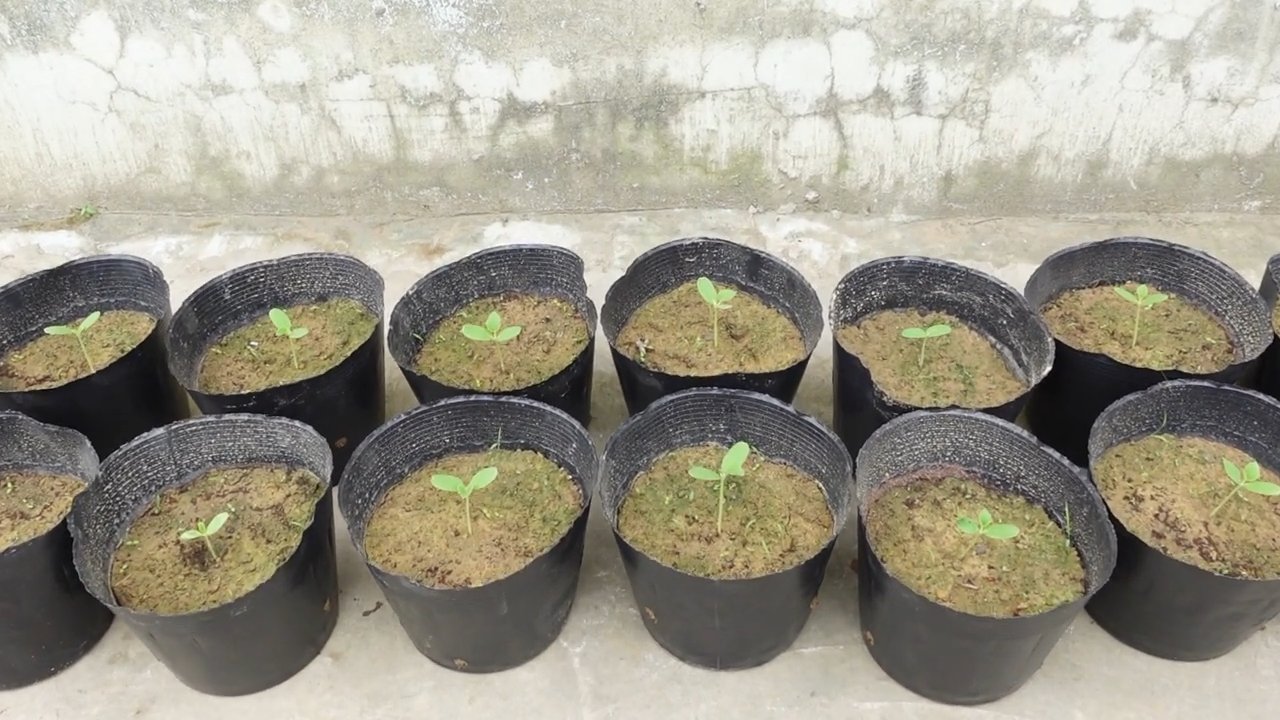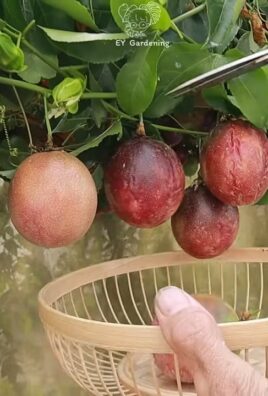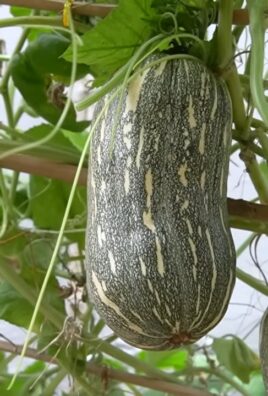Grow Cantaloupe at Home and savor the sweet taste of summer right from your backyard! Imagine biting into a juicy, perfectly ripe cantaloupe that you nurtured from seed to fruit. Forget those bland, store-bought melons – this year, you can enjoy the unparalleled flavor of homegrown cantaloupe.
For centuries, cantaloupe has been cherished for its refreshing taste and nutritional benefits. Originating in Africa and India, this delectable melon made its way across the globe, becoming a symbol of summer abundance and a staple in gardens worldwide. But let’s be honest, successfully growing cantaloupe can feel a bit daunting. That’s where these DIY tricks and hacks come in!
Many gardeners struggle with common cantaloupe growing challenges like vine borers, blossom end rot, and inconsistent ripening. I’ve been there! That’s why I’m sharing my tried-and-true methods to help you overcome these hurdles and achieve a bountiful harvest. Whether you’re a seasoned gardener or just starting out, these simple yet effective techniques will empower you to grow cantaloupe at home with confidence. Get ready to impress your friends and family with your homegrown cantaloupe – let’s get started!

Cantaloupe Anbau zu Hause: Dein DIY-Leitfaden für süße Melonen
Hallo Gartenfreunde! Habt ihr euch jemals vorgestellt, eine saftige, süße Cantaloupe-Melone direkt aus eurem eigenen Garten zu ernten? Ich zeige euch, wie ihr das ganz einfach selbst machen könnt! Cantaloupe-Melonen sind nicht nur köstlich, sondern auch reich an Vitaminen und Antioxidantien. Mit ein wenig Planung und Pflege könnt ihr euch schon bald über eure eigene Ernte freuen. Los geht’s!
Was du für den Cantaloupe-Anbau brauchst
Bevor wir loslegen, hier eine Liste der Dinge, die du benötigst:
* Cantaloupe-Samen: Wähle eine Sorte, die für dein Klima geeignet ist. Es gibt viele verschiedene Sorten, von kleinen, schnell reifenden bis hin zu großen, aromatischen.
* Anzuchttöpfe oder -schalen: Für die Voranzucht der Samen.
* Anzuchterde: Eine leichte, nährstoffarme Erde, die speziell für die Anzucht von Sämlingen entwickelt wurde.
* Gartenerde: Gut durchlässige, nährstoffreiche Erde für das Beet oder den Kübel.
* Kompost oder organischer Dünger: Um den Boden anzureichern.
* Gießkanne oder Gartenschlauch: Für die Bewässerung.
* Mulch: Stroh, Holzhackschnitzel oder ähnliches, um den Boden feucht zu halten und Unkraut zu unterdrücken.
* Rankhilfe (optional): Wenn du Cantaloupe in einem Kübel anbaust oder wenig Platz hast, kann eine Rankhilfe helfen, die Pflanzen zu stützen.
* Gartenschere: Für das Beschneiden der Pflanzen.
* Geduld und Liebe: Das Wichtigste!
Die Vorbereitung: Samen säen und Sämlinge ziehen
Der erste Schritt ist die Voranzucht der Cantaloupe-Samen. Das gibt den Pflanzen einen Vorsprung, besonders in Regionen mit kürzeren Sommern.
1. Samen aussäen: Fülle deine Anzuchttöpfe oder -schalen mit Anzuchterde. Lege pro Topf 2-3 Samen etwa 1-2 cm tief in die Erde. Bedecke die Samen leicht mit Erde und gieße sie vorsichtig an.
2. Feuchtigkeit halten: Die Erde sollte immer leicht feucht sein, aber nicht nass. Am besten sprühst du die Erde regelmäßig mit einer Sprühflasche an.
3. Wärme und Licht: Stelle die Anzuchttöpfe an einen warmen, hellen Ort. Eine Fensterbank mit Südausrichtung ist ideal. Du kannst auch eine Pflanzenlampe verwenden, um sicherzustellen, dass die Sämlinge genügend Licht bekommen. Die optimale Keimtemperatur liegt zwischen 21 und 27 Grad Celsius.
4. Keimung abwarten: Nach etwa 7-14 Tagen sollten die Samen keimen. Sobald die Sämlinge ihre ersten richtigen Blätter (neben den Keimblättern) entwickelt haben, kannst du die schwächeren Pflanzen entfernen, sodass nur noch eine kräftige Pflanze pro Topf übrig bleibt.
5. Abhärten: Bevor du die Sämlinge ins Freie pflanzt, musst du sie abhärten. Das bedeutet, dass du sie langsam an die Bedingungen im Freien gewöhnst. Stelle die Töpfe tagsüber für ein paar Stunden ins Freie und hole sie abends wieder herein. Verlängere die Zeit im Freien jeden Tag um ein paar Stunden, bis die Sämlinge schließlich den ganzen Tag draußen bleiben können.
Der Umzug: Cantaloupe ins Beet oder den Kübel pflanzen
Sobald die Sämlinge kräftig genug sind und die Frostgefahr vorüber ist (normalerweise Mitte Mai), können sie ins Freie gepflanzt werden.
1. Standort wählen: Cantaloupe-Melonen lieben die Sonne! Wähle einen sonnigen Standort mit mindestens 6-8 Stunden direkter Sonneneinstrahlung pro Tag. Der Boden sollte gut durchlässig und nährstoffreich sein.
2. Boden vorbereiten: Lockere den Boden gründlich auf und mische Kompost oder organischen Dünger unter. Cantaloupe-Melonen sind Starkzehrer und benötigen viele Nährstoffe. Der pH-Wert des Bodens sollte idealerweise zwischen 6,0 und 6,8 liegen.
3. Pflanzlöcher graben: Grabe Pflanzlöcher, die etwas größer sind als die Wurzelballen der Sämlinge. Der Abstand zwischen den Pflanzen sollte etwa 60-90 cm betragen, je nach Sorte.
4. Pflanzen einsetzen: Nimm die Sämlinge vorsichtig aus den Anzuchttöpfen und setze sie in die Pflanzlöcher. Achte darauf, dass die Wurzelballen nicht beschädigt werden. Fülle die Löcher mit Erde auf und drücke sie leicht an.
5. Angießen: Gieße die Pflanzen nach dem Einsetzen gründlich an.
6. Mulchen: Bedecke den Boden um die Pflanzen mit Mulch. Das hilft, die Feuchtigkeit im Boden zu halten, Unkraut zu unterdrücken und den Boden warm zu halten.
Die Pflege: Cantaloupe zum Wachsen bringen
Jetzt beginnt die eigentliche Arbeit! Cantaloupe-Melonen brauchen regelmäßige Pflege, um gut zu wachsen und viele Früchte zu tragen.
1. Bewässerung: Cantaloupe-Melonen benötigen viel Wasser, besonders während der Fruchtbildung. Gieße die Pflanzen regelmäßig, aber vermeide Staunässe. Am besten gießt du früh am Morgen, damit die Blätter tagsüber abtrocknen können.
2. Düngung: Dünge die Pflanzen alle 2-3 Wochen mit einem organischen Dünger oder Komposttee. Achte darauf, dass der Dünger reich an Kalium ist, da Kalium die Fruchtbildung fördert.
3. Unkrautbekämpfung: Halte das Beet oder den Kübel unkrautfrei. Unkraut konkurriert mit den Cantaloupe-Melonen um Nährstoffe und Wasser.
4. Beschneiden (optional): Das Beschneiden der Pflanzen kann helfen, die Fruchtbildung zu fördern. Entferne Seitentriebe, die keine Blüten tragen. Lasse pro Pflanze nicht mehr als 4-6 Früchte reifen, damit die Pflanzen ihre Energie auf die Entwicklung der Früchte konzentrieren können.
5. Schutz vor Schädlingen und Krankheiten: Cantaloupe-Melonen können von verschiedenen Schädlingen und Krankheiten befallen werden, wie z.B. Blattläusen, Mehltau und Wurzelfäule. Kontrolliere die Pflanzen regelmäßig und behandle sie bei Bedarf mit geeigneten Mitteln. Bei Blattläusen hilft oft schon ein kräftiger Wasserstrahl. Gegen Mehltau kannst du mit einer Mischung aus Wasser und Backpulver (1 Teelöffel Backpulver auf 1 Liter Wasser) vorgehen. Achte auf eine gute Belüftung der Pflanzen, um Krankheiten vorzubeugen.
6. Rankhilfe (optional): Wenn du Cantaloupe in einem Kübel anbaust oder wenig Platz hast, kann eine Rankhilfe helfen, die Pflanzen zu stützen. Die schweren Früchte können sonst die Triebe abbrechen.
Die Ernte: Cantaloupe-Melonen genießen
Nach etwa 80-90 Tagen (je nach Sorte) sind die Cantaloupe-Melonen reif.
1. Reife erkennen: Es gibt verschiedene Anzeichen, die darauf hindeuten, dass eine Cantaloupe-Melone reif ist:
* Die Schale verfärbt sich von grün nach gelb oder orange.
* Die Melone duftet aromatisch.
* Der Stiel löst sich leicht von der Frucht.
* Die Schale gibt bei leichtem Druck etwas nach.
2. Ernten: Schneide die reife Melone vorsichtig mit einem scharfen Messer oder einer Gartenschere vom Stiel ab.
3. Genießen: Schneide die Cantaloupe-Melone auf und genieße das saftige, süße Fruchtfleisch! Cantaloupe-Melonen sind pur ein Genuss, aber auch in Salaten, Smoothies oder als Dessert ein Highlight.
Zusätzliche Tipps für den Cantaloupe-Anbau
* Bienenfreundliche Pflanzen: Pflanze in der Nähe deiner Cantaloupe-Melonen bienenfreundliche Pflanzen wie Lavendel, Sonnenblumen oder Ringelblumen. Bienen sind wichtig für die Bestäubung

Conclusion
So, there you have it! Growing cantaloupe at home might seem daunting at first, but with a little planning, patience, and the right techniques, you can enjoy the sweet, juicy reward of homegrown melons. This DIY approach not only saves you money compared to buying them at the store, but it also allows you to control the growing process, ensuring you get the freshest, most flavorful cantaloupe possible.
Why is this DIY trick a must-try? Because it empowers you to cultivate a taste of summer right in your backyard! Imagine biting into a perfectly ripe cantaloupe, knowing you nurtured it from seed to fruit. The satisfaction is unparalleled. Plus, you’ll avoid the pesticides and preservatives often found in commercially grown produce. You’ll also be contributing to a more sustainable lifestyle by reducing your reliance on long-distance transportation of food.
But the benefits don’t stop there. Growing your own cantaloupe is a fantastic learning experience, especially for families with children. It teaches valuable lessons about plant life cycles, responsibility, and the importance of healthy eating. It’s a hands-on science project that yields a delicious and nutritious outcome.
Looking for variations or suggestions? Consider these ideas to personalize your cantaloupe growing experience:
* Vertical Gardening: If you’re short on space, try growing your cantaloupe vertically on a trellis. This not only saves space but also improves air circulation, reducing the risk of fungal diseases. Choose a sturdy trellis that can support the weight of the mature melons.
* Companion Planting: Plant basil, marigolds, or nasturtiums near your cantaloupe to deter pests and attract beneficial insects. These companion plants can help create a healthier and more productive garden environment.
* Different Varieties: Experiment with different cantaloupe varieties to find your favorite. Some popular choices include ‘Athena’, ‘Hales Best Jumbo’, and ‘Honey Rock’. Each variety has its own unique flavor, size, and ripening time.
* Container Gardening: If you don’t have a garden, you can still grow cantaloupe in large containers. Choose a container that is at least 24 inches in diameter and 18 inches deep. Make sure the container has drainage holes to prevent waterlogging.
* Extend the Season: Use row covers or cold frames to protect your cantaloupe plants from frost and extend the growing season. This is especially helpful in cooler climates.
We strongly encourage you to give this DIY trick a try. The process of growing cantaloupe at home is incredibly rewarding, and the taste of a homegrown melon is simply unmatched. Don’t be afraid to experiment and adapt the techniques to suit your specific growing conditions.
Most importantly, we want to hear about your experience! Share your tips, successes, and challenges in the comments below. Let’s build a community of cantaloupe growers and learn from each other. Post pictures of your thriving vines and juicy harvests. Together, we can make this DIY project a resounding success! So, grab your seeds, prepare your soil, and get ready to enjoy the sweet taste of homegrown cantaloupe. Happy gardening!
Frequently Asked Questions (FAQ)
What is the best time to plant cantaloupe seeds?
The ideal time to plant cantaloupe seeds is after the last frost, when the soil temperature has reached at least 65°F (18°C). Cantaloupe requires warm weather to thrive, so planting too early can stunt their growth or even kill them. In most regions, this means planting in late spring or early summer. You can start seeds indoors 3-4 weeks before the last frost to get a head start, but be sure to harden them off before transplanting them outdoors.
How much sunlight do cantaloupe plants need?
Cantaloupe plants need at least 6-8 hours of direct sunlight per day to produce healthy vines and sweet, flavorful melons. Choose a planting location that receives full sun throughout the day. If you live in a particularly hot climate, some afternoon shade may be beneficial to prevent the plants from overheating.
What type of soil is best for growing cantaloupe?
Cantaloupe plants prefer well-drained, fertile soil with a pH between 6.0 and 6.8. Amend your soil with compost or other organic matter to improve drainage and fertility. Avoid heavy clay soils, as they can become waterlogged and inhibit root growth. A slightly sandy loam is ideal.
How often should I water my cantaloupe plants?
Water your cantaloupe plants deeply and regularly, especially during hot, dry weather. Aim to keep the soil consistently moist but not waterlogged. Water at the base of the plants to avoid wetting the foliage, which can increase the risk of fungal diseases. As the melons begin to ripen, reduce watering slightly to concentrate the sugars and improve flavor.
How do I know when a cantaloupe is ripe?
There are several indicators that a cantaloupe is ripe and ready to harvest:
* Color: The skin of the cantaloupe will change from green to a tan or yellowish color.
* Aroma: A ripe cantaloupe will have a sweet, musky aroma, especially near the stem end.
* Stem: The stem will begin to crack and separate easily from the vine. This is known as “slipping.”
* Sound: When you tap on a ripe cantaloupe, it will have a dull, hollow sound.
What are some common pests and diseases that affect cantaloupe plants?
Some common pests that can affect cantaloupe plants include aphids, squash bugs, cucumber beetles, and vine borers. Common diseases include powdery mildew, downy mildew, and fusarium wilt. To prevent pest and disease problems, practice good garden hygiene, such as removing weeds and debris, and rotate your crops each year. You can also use organic pest control methods, such as insecticidal soap or neem oil.
Can I grow cantaloupe in containers?
Yes, you can grow cantaloupe in containers, but you’ll need to choose a large container that is at least 24 inches in diameter and 18 inches deep. Use a high-quality potting mix and provide plenty of sunlight and water. You may also need to provide support for the vines, such as a trellis or stake. Choose a compact cantaloupe variety that is well-suited for container gardening.
How do I pollinate cantaloupe flowers?
Cantaloupe plants have separate male and female flowers. Bees and other pollinators are typically responsible for transferring pollen from the male flowers to the female flowers. If you’re not seeing many bees in your garden, you may need to hand-pollinate the flowers. To do this, use a small paintbrush to collect pollen from the male flowers and then gently brush it onto the stigma of the female flowers.
How do I store cantaloupe after harvesting?
Store ripe cantaloupe in the refrigerator for up to a week. Cut cantaloupe should be stored in an airtight container to prevent it from drying out. You can also freeze cantaloupe for later use in smoothies or desserts. To freeze cantaloupe, cut it into cubes and spread them out on a baking sheet. Freeze for several hours, then transfer the frozen cubes to a freezer bag or container.
What are the nutritional benefits of eating cantaloupe?
Cantaloupe is a good source of vitamins A and C, as well as potassium and fiber. It is also low in calories and fat. Vitamin A is important for vision, immune function, and cell growth. Vitamin C is an antioxidant that helps protect against cell damage. Potassium helps regulate blood pressure and muscle function. Fiber promotes digestive health and helps you feel full.




Leave a Comment